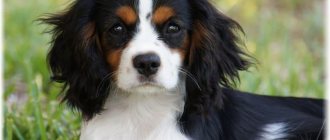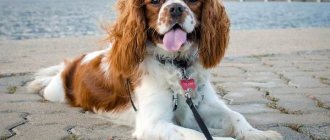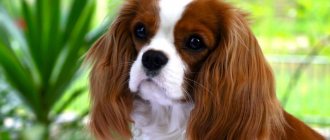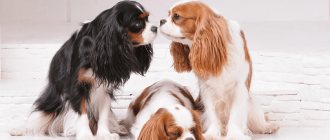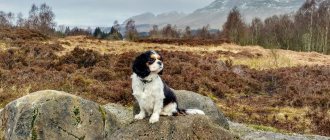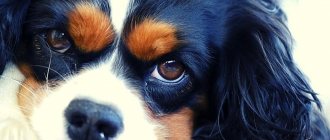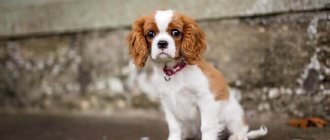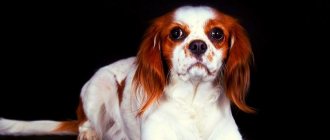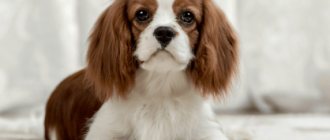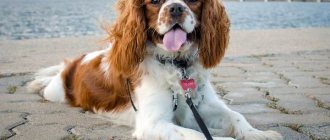Cavalier King Charles Spaniel
Cavalier King Charles Spaniel Cavalier King Charles Spaniel BREED STANDARD CAVALIER KING CHARLES SPANIEL FCI No. 136 Original name Cavalier King Charles Spaniel Other names English Toy Spaniel. English toy spaniel group 9. Section 7. English Toy Spaniels Country of origin - Great Britain Height at withers. 25-34 cm. Weight. 5-9 kg. General impression : Active, graceful, well balanced dog with a soft expression. Personality: Athletic, loving, absolutely fearless. Temperament : Cheerful, friendly, not aggressive, no signs of nervousness. Head and skull. The skull is almost flat between the ears. Not a deep stop. Length from base of stop to tip of nose approximately 1.5 inches (3.8 cm). The nose is black, well developed without uncolored spots, the muzzle is cone-shaped. The lips are well developed but not drooping. The head is well filled under the eyes. Soft, pleasant features; any roughness of form is undesirable. Eyes. Large, dark, round, but not convex, widely spaced. Ears. Long, set high, with copious amounts of hair. Bite . The jaws are strong, with a perfect, regular and complete scissor bite, that is, the upper teeth closely overlap the lower teeth and are set perpendicular to the jaw. Neck. Medium length, with a slight bend.. Front part. The chest is medium, sloping shoulder blades, straight forelimbs with medium-sized bones. Torso . The loin is short, the ribs are well tense. Straight back. Rear end . Limbs with medium bones, parallel, with regular angles. Paws. Compact, with developed pads and good hair growth. Tail. The tail is set correctly. The length of the tail is balanced with the length of the body. The dog carries its tail cheerfully, but never much above the line of the back. Gait. Free, elegant movements, with a strong rear push. The forelimbs and hindlimbs move parallel when viewed from front and rear. Wool. Long, thick, silky, straight, slight waviness is allowed. Absolutely no trimming. Colors. The following colors are recognized as standard. Black and tan. Absolutely black (raven) with red tan on the eyebrows, on the cheeks, inside the ears, on the chest, paws, and the underside of the tail. Red tan should be bright. White spots are undesirable. Ruby. Solid color of bright chestnut color. White spots are undesirable. Blenheim. Bright chestnut, well-separated spots on a pearly white background. The chestnut spots are symmetrically located on the head, leaving space between the ears for the diamond-shaped spot, which is a unique characteristic of the breed. Tricolor. Black and white, well-spaced spots, with red tan on the eyebrows, cheeks, inside the ears, chest, paws, and underside of the tail. Any other colors or combinations thereof are undesirable. Weight . 12-18 lbs (5.5 -8.2 kg) A small, well-balanced dog within this weight range is most desirable. Flaws. Any deviations from the standard should be considered defects, the severity of the defect being taken into account in proportion to the severity of these deviations. Note : Males must have two normally developed testes, fully descended into the scrotum.
King Charles Spaniel - reviews
- + Leave a review
Gulya
12/02/2021 at 14:32Answer
It’s strange, the topic is called King Charles Spaniel, but everyone writes about the Cavalier King Charles Spaniel, and yet these are completely different breeds.
Leave a review Reset
TestE
https://otzovik.com/review_6896280.html
- Choosing a puppy and price Basically, all puppies are sold with puppy metrics (pedigreed). You are unlikely to be able to find a purebred cavalier who is sold just like that. And all purebred puppies are known to be expensive. The price varies - from 35 to 80 (St. Petersburg). And you will also need to buy toys, bedding, food, hygiene products, etc.
- At first we got a puppy at the age of 2 months. During the day, my husband and I were at work, so the puppy had to sit alone all day. We were very worried that he wouldn’t be able to, would be rowdy or, on the contrary, would withdraw... But in the end, the puppy adapted very quickly (only in the first couple of days he was afraid and was extremely modest). Then he jumped, ran, bit everything and everyone) But most importantly, he calmly endured and tolerates our absence (does not bark, does not damage furniture, does not fall into hysterics...). Of course, while he was small, we tried not to leave him for too long; we came home as early as possible.
- Food We decided that we would feed our dog dry food (holistic grade). These foods are balanced and there are many different flavors and manufacturers. Considering that the breed is not large, packs of food last a long time. Feeding with food is optimal in my opinion. Providing a balanced diet with natural feeding is quite difficult and more expensive (both in terms of money and time). The dog eats the food well (we periodically change the taste, but not the manufacturer - it’s better not to change it if your dog eats with appetite and tolerates it well).
- Overall assessment The dog is very quiet - ours doesn’t bark at all, very rarely, he growls/gurls/purrs, but doesn’t bark
